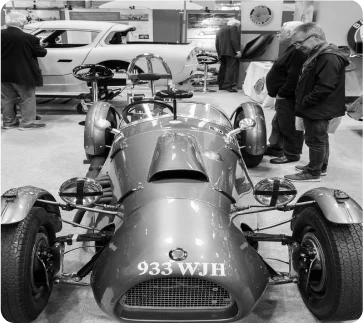THE CARS
Chrysler- engine models
All later production Bristols were to be fitted with Chrysler V8 engines of various capacities from 5,130cc upwards, together with the Torqueflite automatic gearbox.

The Chrysler-engined models began with the Type 407 in 1961, which apart from the engine and gearbox, looks very similar to the 406.
In 1964 this was succeeded by the Type 408, itself followed two years later by the Type 409, and in 1967 by the Type 410.
Then in 1970 came the Type 411, which that very experienced motoring journalist John Bolster called “the fastest true four-seater touring car”. With an engine of 6,277cc capacity, and a maximum speed of 140mph, this set new standards for those seeking the ultimate in speed with comfort. Unusually for a Bristol, this model was to continue through four further series, not being supplemented by the Type 412 until 1975. This was another watershed so far as outward appearance was concerned, for its convertible body style was to be developed into two versions of the second series. The American export model was called the 412 USA and later the series 3 version of the UK car being called the Bristol Beaufighter. Yet another variation given another famous Aeroplane name and one which is now equally rare is the Bristol Beaufort. This was based on the Beaufighter internals, but fitted with an electric roof, no roll cage and many detail alterations in the coachwork, too numerous to describe here.
A frequent query is “why was the Bristol model that succeeded the Type 411 called the Type 603?” The answer is that it was introduced in the 603rd year after the City of Bristol had been granted its Royal charter, which gave it the unique distinction of being a County unto itself. No doubt superstition played a small part in preventing the release of a Type 413!
The Type 603 made its appearance in 1976, and was rather more in the earlier tradition – a magnificent four seater, fulfilling the Bristol criterion for a car that can carry four six footers, with sufficient luggage to last a fortnight! It is perhaps typical of the company, that just as other manufacturers were dropping names for numbers, Bristol Cars Ltd chose to drop the latter in favour of titles – all evocative of the aircraft formerly made by the Bristol Aeroplane Company.
Thus we have seen the Type 603 s2 evolve into the Bristol Britannia, a beautifully proportioned saloon, and its more powerful partner the Bristol Brigand, similar in appearance but fitted with a turbocharged engine.
In 1994, the Type 603 s4 or Bristol Blenheim appeared and was to be continued in production until late 1997. On 14 January 1998, the Bristol Blenheim 2 was announced, being the latest derivation of the Type 603 s4 and wholly in line with customer requirements. No longer Rotomaster Turbo Charged, but fitted instead with a computerised direct fuel injection system to its specially developed Chrysler 5.9 litre V8 engine, which is also software upgradeable, to produce even more power, should it be required. Many changes were made to the rear of the body shell of the car which was completely redesigned.
In November 1999, the Bristol Blenheim 3 was revealed, advancing further the aerodynamic development of the the car including a completely new frontal treatment incorporating a cleverly engineered aerofoil section in the grille aperture. There were many other changes under the skin, and also new headlight units.
Want to know more?
We’re always happy to make new friends, so if you’d like discover the benefits of becoming a member today, read a little more about our membership.

